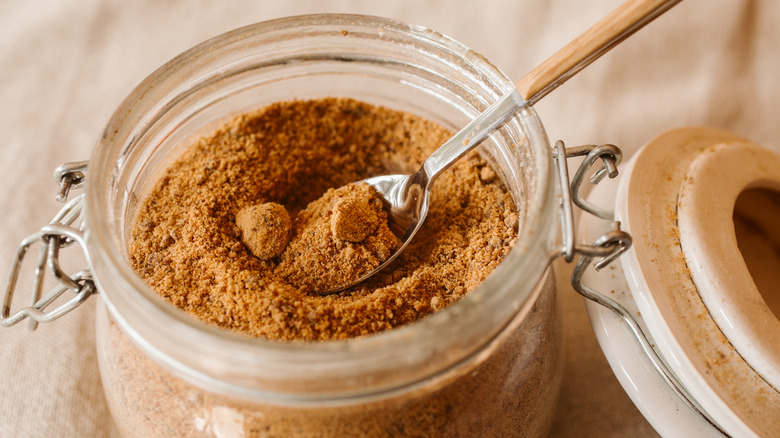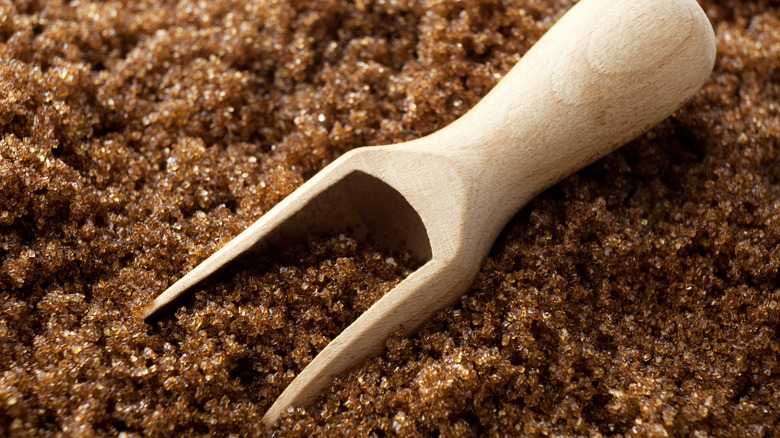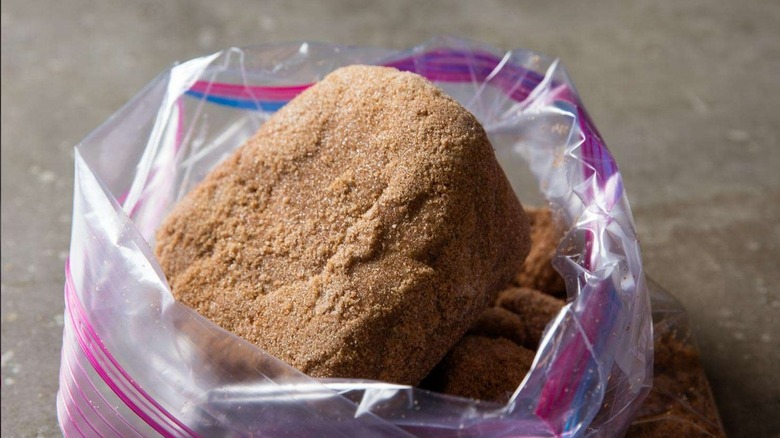How The Size Of Your Container Is Sabotaging Your Brown Sugar
As many of us have unfortunately discovered, brown sugar can be a tricky ingredient to store long-term. One small mistake, and you're left with a solid rock of sugar that can't even be split apart with a knife, much less mixed into cake batter or cookie dough. This can even happen when you store the sugar in a sturdy jar or container, which seems to be a great method for virtually every other baking staple.
It turns out that brown sugar's biggest enemy is exposure to air – and not even an airtight container is sure to keep it moist and malleable. Too large of a container can still trap air inside, so if your jar contains more empty space than sugar, you'll encounter those dreaded brown sugar blocks very soon. Instead, store your brown sugar in the smallest airtight container as possible, limiting how much air is sealed within.
To minimize air exposure even further, consider switching from glass containers to resealable plastic bags. While it might be aesthetically pleasing to store your pantry staples in matching containers, it's better to load brown sugar into a bag (again, as small as you can manage), press it flat, and squeeze out as much air as possible. If you prefer to keep goods in their original packaging instead of decanting, fold the top of your brown sugar bag over and secure tightly with a rubber band. Trust us, these steps will be worth it in the long run.
More ways to keep your brown sugar soft and fresh
Airtight containers or bags are the best storage vessels for brown sugar, but there are also other tricks that can help to keep it soft. You can toss moist ingredients into your container to stop the sugar from drying out. Marshmallows are a popular choice, as they're cheap, effective, and you only need to use one, unless you're storing a lot of sugar. Alternatively, you can soften brown sugar with a single slice of bread or even with apple slices. All three of these options reintroduce moisture to the sugar's environment, keeping it fresh.
Another aspect of storing brown sugar properly has to do with climate. This type of sugar should be kept somewhere cool, but not cold. You should avoid keeping it in the refrigerator, as the dry, cold air inside will quickly cause clumping. For long-term storage, you can put brown sugar in the freezer, but this can also result in loss of moisture once thawed.
Although the label on your package of brown sugar might say it stays good for up to two years, the quality will start to suffer after only six months. You might notice changes in flavor or crystallization over time. Overall, the best move is to buy brown sugar in smaller quantities, store it in some kind of airtight container with another moisture-rich food, and use it up as quickly as you can.
What to do if your brown sugar turns into a rock
Whether your brown sugar was stored improperly or you just have bad luck, you might open your package to find that the grains have turned into a dense block. How are you supposed to make the best chewy cookies ever with sugar that's chunky and crystallized? Worry not, as you can fix the problem in a few ways.
One method is to bake the sugar at 250 degrees Fahrenheit until it starts to soften. Spread it out on a lined baking sheet and watch it closely, lest it melt and burn. Alternatively, heat up the sugar in a bowl in the microwave, covering it with a damp paper towel to provide extra moisture. Either way, use the sugar while it's hot, as it will harden again once it cools. If heating the sugar makes you nervous, dump it in a blender or food processor and give it a few pulses to break it down. If you end up with leftover sugar, be sure to store it properly to minimize further clumping.
If you have a little more time on your hands, the aforementioned marshmallow, bread, or apple tricks will also fix already-hard brown sugar. Toss in a piece of your chosen food, and let it sit for at least 24 hours to transfer moisture to the sugar. You should then be able to break up the chunks with a fork.



